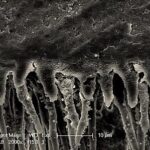
There are a wide range of dental adhesive systems however; the same protocol is assigned by manufacturers for primary and permanent teeth, despite chemical and morphological differences between dentin substrates (Dental Elf – 29th Jun 2018). Primary dentine has a higher tubular density, large diameters and low mineral content. Therefore, increased demineralisation occurs in primary teeth, resulting in a thicker hybrid layer and lower bond strength values. To improve adhesion, studies have recommended a reduction in etching time.
The aim of this systematic review and meta-analysis was to investigate the influence of reducing the etching time on the dentine of primary teeth for bonding with etch-and-rinse and self-etching adhesive systems.
Methods
The Preferred Reporting Items for Systematic Review and Meta-Analyses (PRISMA) were used to inform the methodology of this review. PubMed/Medline, Scopus and Web of Science were the databases searched. Studies were included if they were laboratory studies that evaluated the bond strength of adhesive systems to primary dentin including reducing the etching time before using the adhesive systems. Risk of bias was assessed through criteria described on a previous systematic review1.
Results
- 1625 articles were retrieved across the initial database search. Following removal of duplicates and implementation of the inclusion and exclusion criteria, 8 studies were included for qualitative assessment and from this, 7 for quantitative synthesis.
- 6 studies considered sound dentine as a bonding substrate however 2 studies also included caries-affected dentine.
- Most studies used a Single Bond/Adper Single Bond 2. All studies that evaluated the bond strength using self-etching adhesive systems used ClearFil SE Bond and 2 studies used the adhesive One-Up Bond F.
- The reduced time of acid etching or primer application did not have significant impact on the immediate bond strength values (P=0.74) however resulted in significantly greater bond strength values (P=0.04) when specimens were tested after 12 months of water storage.
- The overall meta-analysis of long-term bond strength values identified no significant differences (p=0.45).
- No significant heterogeneity was observed in the overall and subgroup analysis.
- All included studies had a high risk of bias.
Conclusions
The authors concluded:-
…Reducing the acid-etching time to primary dentine improves the long-term bond strength of etch-and-rinse adhesive to this substrate.
Comments
This systematic review and meta-analysis showed that reductions in acid-etching and primer application did not impact the immediate bond strength. This has potential implications for reducing working time which is especially important in young patients where cooperation may be challenging. Whilst the authors concluded that reducing the acid-etching time improved the long-term bond strength of etch-and-rinse adhesives, only 2 studies were pooled in this sub-group analysis and all studies were reported as having a high risk of bias. Furthermore, these are laboratory based studies so may not be wholly representative of the clinical environment. Therefore, no changes in clinical practice can be recommended based on the current level of evidence. Nonetheless, this systematic review and meta-analysis does highlight the need for a well-designed clinical study investigating long-term bond strength.
Links
Primary Paper
Gindri, LD, Fröhlich, TT, Rosso, CR, Rocha, RDO. Etching time and bonding of adhesive systems to dentin of primary teeth: A systematic review and meta‐analysis. Int J Paediatr Dent. 2020; 00: 1– 9.
Other references
Sarkis-Onofre R, Skupien JA, Cenci MS, Moraes RR, Pereira-Cenci T. The role of resin cement on bond strength of glass-fiber posts luted into root canals: a systematic review and meta-analysis of in vitro studies. Oper Dent. 2014 Jan-Feb;39(1):E31-44. doi: 10.2341/13-070-LIT. Epub 2013 Aug 12.
Dental Elf – 29th June 2018
Dental adhesive systems: HEMA-free or HEMA-containing systems?
